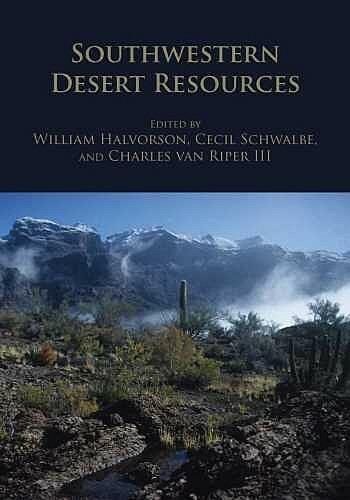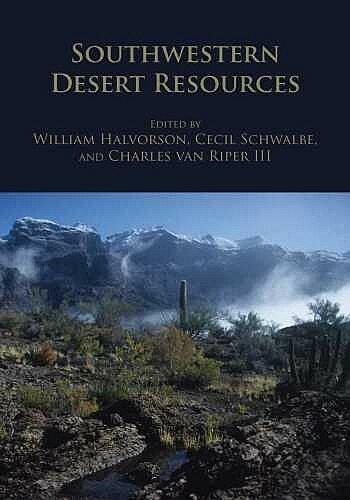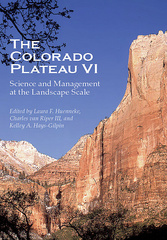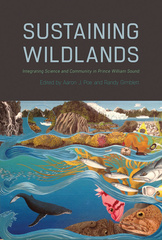Southwestern Desert Resources
The University of Arizona Press
The southwestern deserts stretch from southeastern California to west Texas and then south to central Mexico. The landscape of this region is known as basin and range topography featuring to “sky islands” of forest rising from the desert lowlands which creates a uniquely diverse ecology. The region is further complicated by an international border, where governments have caused difficulties for many animal populations.
This book puts a spotlight on individual research projects which are specific examples of work being done in the area and when they are all brought together, to shed a general light of understanding the biological and cultural resources of this vast region so that those same resources can be managed as effectively and efficiently as possible. The intent is to show that collaborative efforts among federal, state agency, university, and private sector researchers working with land managers, provides better science and better management than when scientists and land managers work independently.
This book puts a spotlight on individual research projects which are specific examples of work being done in the area and when they are all brought together, to shed a general light of understanding the biological and cultural resources of this vast region so that those same resources can be managed as effectively and efficiently as possible. The intent is to show that collaborative efforts among federal, state agency, university, and private sector researchers working with land managers, provides better science and better management than when scientists and land managers work independently.
William Halvorson is a research ecologist with the with the U.S. Geological Survey’s Southwest Biological Science Center at the Sonoran Desert Research Station. He is also a faculty member at the School of Natural Resources and Environment at The University of Arizona.
Introduction
William L. Halvorson
AREA INVENTORIES
1. Vascular Plant and Vertebrate Inventory of Casa Grande Ruins National Monument
Brian F. Powell, Eric W. Albrecht, Cecilia A. Schmidt, Pamela Anning, and Kathleen Docherty
2. Vascular Plant and Vertebrate Inventory of Tumacácori National Historic Park
Brian F. Powell, Eric W. Albrecht, Cecilia A. Schmidt, Pamela Anning, and Kathleen Docherty
3. Plant and Vertebrate Inventory of Organ Pipe Cactus National Monument
Cecilia A. Schmidt and Brian F. Powell
4. Vascular Plant and Vertebrate Inventory of Saguaro National Park, Rincon Mountain District
Brian F. Powell and Cecilia A. Schmidt
5. Vegetative Characteristics of Oak Savannas in the Southwestern Borderlands Region
Peter F. Ffolliott and Gerald J. Gottfried
6. Distribution and Conservation Protection of Natural Land Cover in the Sonoran Desert Ecoregion in Arizona, as Described by the Southwest Regional GAP Analysis Project
Kathryn A. Thomas, Keith A. Schulz, and Ken Boykin
7. Vertebrate Species in Desert Caves and Mines — A Comparison Between the Chihuahuan and Sonoran Deserts
Thomas R. Strong
STATUS OF RESOURCES
8. Implications of Illegal Border Crossing and Drug Trafficking on the Management of Public Lands
Craig C. Billington, Randy Gimblett, and Paul R. Krausman
9. The U.S.-Mexico Border and Endangered Species
Douglas K. Duncan, Erin Fernandez, and Curtis McCasland
10. Adaptive Management of the Grassland-Watershed at Las Cienegas National Conservation Area: the Role of Monitoring, Rancher Engagement, and Multi-Stakeholder Advisory Teams
David Gori, Karen Simms, Mac Donaldson, Gitanjali Bodner, and Heather Schussman
11. Ecology and Conservation in the Sonoyta Valley, Arizona and Sonora
Philip C. Rosen, Cristina Melendez, J. Daren Riedle, Ami C. Pate, and Erin Fernandez
12. Overview of the Lower Colorado River Multi-Species Conservation Program
William E. Werner
13. Termite Activity on Green Tissues of Saguaro (Carnegiea gigantea) in the Sonoran Desert
Alejandro E. Castellanos, Reyna A. Castillo, Adrian Quijada
14. Conservation of Amphibians and Reptiles in Northwestern Sonora and Southwestern Arizona
James C. Rorabaugh
15. Observations on the Status of Aquatic Turtles and the Occurrence of Ranid Frogs and Other Aquatic Vertebrates in Northwestern Mexico
Philip C. Rosen and Cristina Melendez
16. Challenges to Natural Resource Monitoring in a Small Border Park: Terrestrial Mammals at Coronado National Memorial, Cochise County, Arizona
Don E. Swann, Melanie Bucci, Amy J. Kuenzi, Barbara N. Alberti, and Cecil Schwalbe
17. The Small Mammal Community Associated with Ironwood (Olneya tesota)
Helí Coronel-Arellano and Carlos A. López-González
18. Finding that 4-star Diner or How Bats Might “Anticipate” Productive Foraging Areas
Debbie C. Buecher, Ronnie Sidner, and John L. Koprowski
19. Advancing Large Carnivore Recovery in the American Southwest
Tony Povilitis and C. Dustin Becker
20. Conservation Genetics of Black Bears in the Sky Islands of Arizona and Northern Mexico
Cora Varas, Carlos A. López-González, Paul R. Krausman, and Melanie Culver
21. Recovery Efforts for the Sonoran Pronghorn in the United States
Ryan R. Wilson, Paul R. Krausman, and John R. Morgart
22. Current Status of Mountain Lions and Urban Issues in Tucson, Arizona
Kerry L. Nicholson, Lisa Haynes, and Paul R. Krausman
SOCIAL AND CULTURAL ISSUES
23. Modeling Airborne Mineral Dust: A Mexico – United States Trans-boundary Perspective
Dazhong Yin and William A. Sprigg
24. Open Space Protection as a Means of Urban Containment: A Case Study from Colorado
David Pesnichak
25. Historic Transportation Corridors in the Southwest, 1536 – Present
Eric Vondy
List of Contributors
Index







